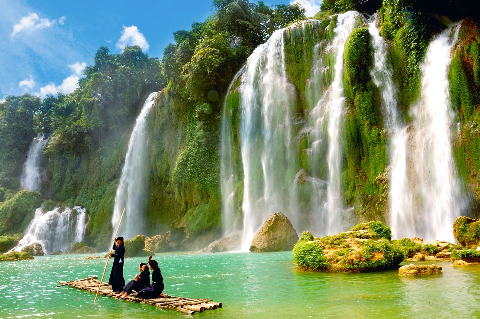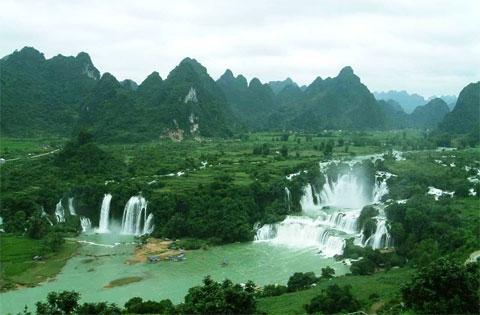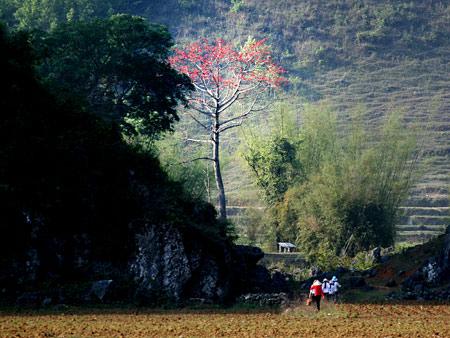Perhaps all Vietnamese people know about the name Pac Bo and its association with Uncle Ho in history classes from elementary school or in documentary films.
However, last month a group of friends and I had a chance to visit the place where Uncle Ho lived and worked as he planned the revolution after returning from his 30 years abroad to seek ways for the nation’s liberation.

Travelers visit the place where Uncle Ho used to fi sh in 1941
Pac Bo is located in Ha Quang District of Cao Bang Province, about 50 kilometers from Cao Bang Town. The road from Cao Bang Town to Pac Bo is flanked by towering mountains and rice fields and small hamlets with dozens of stilt houses under the shade of clusters of peach trees, and the winding streams with thatched-roofed bridges in Nung and Tay villages along the way.

Tourists walk along the scenic road near the border belt with China in Pac Bo area
Therefore, after an hour or so following the scenic road, we reached upon the site in a comfortable and excited state.
We then were joined by a young female tour guide of the tourist area. She took us to the first stop which was the newly-built Ho Chi Minh Museum. We had an opportunity to review what we had learnt at school and much more about this remarkable time and location of the country’s revolution, artifacts of Uncle Ho accompanied with images of soldiers and officers. The museum also impressed with bas-reliefs and statues depicting historical events.
We then went to the Lenin Stream at the foot of Karl Marx Mountain. The stream features clear, cool and tranquil water so that tourists can see fish swimming underwater.
Walking on the rocks along the side of the stream, where Uncle Ho used to work and fish, visitors reach a wooden bridge over Coc Bo rivulet where Lenin Stream starts.

Visitors take photos at Lenin Stream under the foot of Karl Marx Mountain -
Photos: My Tran
Halfway up the mountain is Coc Bo Cave, which is cold and humid, where Uncle Ho settled. Looking down into the cave from its mouth, you can see the words February 8th, 1941 written by Uncle Ho on the wall. In the distance, on the stream’s bank is the stone table where he translated the Democratic Republic of Vietnam’s history. Each artifact remains to this day.

Uncle Ho’s bed in Coc Bo Cave
About 1km from the mouth of Coc Bo Cave, there is a small hut by the side of Khuoi Nam Mountain. In this hut, Uncle Ho held the eighth Party Central Committee Meeting, which promulgated a resolution on preparations for the armed insurrection and the establishment of the Viet Minh and the revolutionary war zone. Adjacent to the hut is the milestone 108 marking the Vietnam - China border.
Visiting this historical area, travelers will learn more about the life and devotion of President Ho Chi Minh which is partly reflected through his optimistic revolutionary verses.














 Betsy ordered this interesting dish at Morning Glory...a shrimp coconut curry actually cooked in a young coconut. The sauce was slightly sweet and unbelievably flavorable.
Betsy ordered this interesting dish at Morning Glory...a shrimp coconut curry actually cooked in a young coconut. The sauce was slightly sweet and unbelievably flavorable. Congee for breakfast with a cup of coffee in the background. I love the little coffee filter so it can brew right at the table!
Congee for breakfast with a cup of coffee in the background. I love the little coffee filter so it can brew right at the table! "Pho", aka noodle soup, with a plate of fresh herbs and some fresh coconut water. You can't get much healthier than that!
"Pho", aka noodle soup, with a plate of fresh herbs and some fresh coconut water. You can't get much healthier than that! Eating my sweet green bean soup, served cold in a glass
Eating my sweet green bean soup, served cold in a glass












